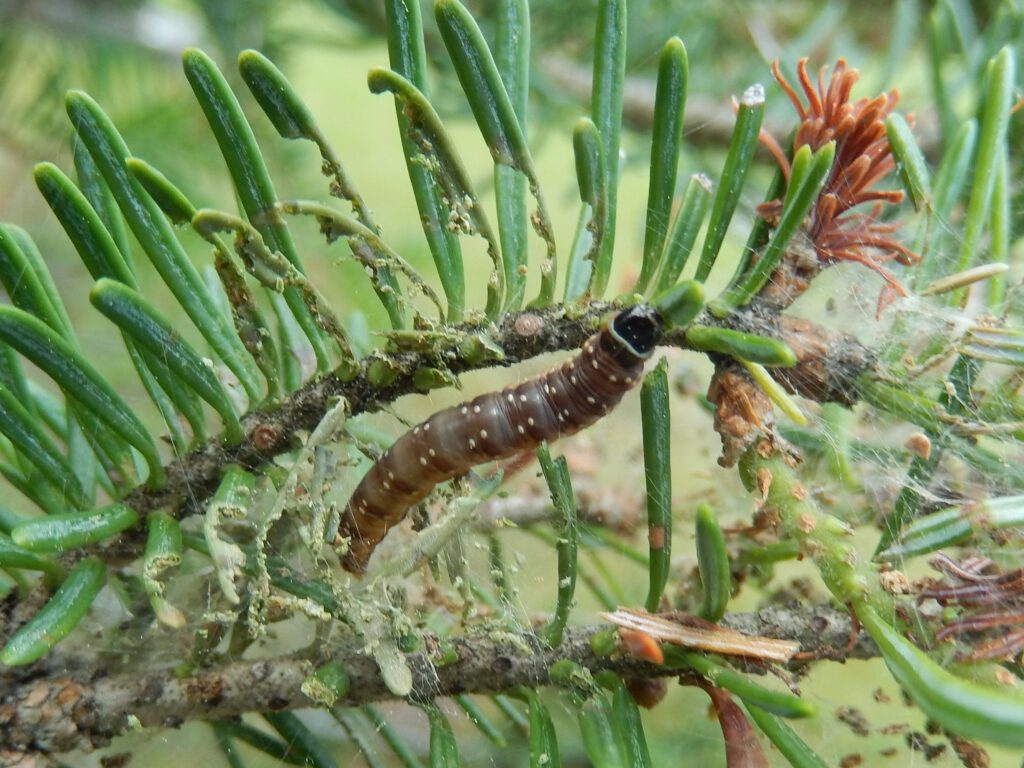
Getting to Know Your Forest Health Team: Linda Williams on Spruce budworm
By Denise Thornton
Spruce budworm (Choristoneura fumiferana) has been causing defoliation in Wisconsin since 2012 according to Linda Williams, Wisconsin DNR forest health specialist. This pest is native to the Great Lakes area, where outbreaks have been occurring every 30-50 years.
“Our last round was in the 1970s. Ten years is about average for an outbreak,” says Williams. “I would suspect this one will be wrapping up in the next several years. The whole population tends to collapse at the same time, but we cannot predict exactly when that might happen.”
Defoliation was first spotted in Marinette County, but is now found across much of northern Wisconsin. “In particular, we are seeing significant defoliation in Northeast and North Central Wisconsin, and the area extends to the UP, Minnesota, and Ontario,” she says.
Spruce budworm will defoliate spruce and balsam fir. “Historically it has been hard on white spruce in plantations. We also have black spruce swamps — low areas where black spruce grows naturally — although black spruce is not defoliated as much by spruce budworm,” Williams says. “Balsam fir, which spruce budworm actually prefers, can be found in plantations, but also grows naturally in understories, growing very densely up to 30 feet tall.”
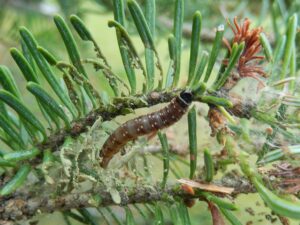
In spring, spruce budworm caterpillars feed on buds just starting to break, and also on pollen cones. “They finish eating fairly early in the year and pupate right on the needles before people usually even notice the damage,” says Williams. “After a couple weeks in the pupa, they emerge as small, reddish brown moths, mate, lay eggs and are done for the year.”
The new needles are most at risk, “but after the new needles have been eaten on a tree for two or three years, there aren’t many needles left on the tree,” she says. “Unlike our hardwoods — which, if their leaves are eaten early in spring, will send out additional leaves to get them through the rest of the year — our conifers don’t re-foliate after their needles have been eaten. The growth they push out in the spring is all they’ve got. These trees can suffer top die-back or die completely.”
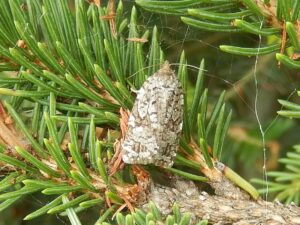
Early in spring, the caterpillars are about a quarter inch long. They grow to about an inch long and tend to be a brownish-green color that blends in well. They tend to web together a couple of needles and hide inside. “They are not easy to spot even when there are thousands of them,” Williams says. “They are messy feeders though. They sometimes clip needles without eating them completely, and the clipped needles get caught in the webbing they create around the tree. Eventually, the clipped-off needles turn a reddish-brown, and the tree will look like it is scorched. That stands out from the air, and it is something we look for in aerial surveys.”
“How to respond depends on the situation,” says Williams. “It’s good for plantation owners to evaluate their trees each year and determine if any are starting to decline or looking thin. If you have a plantation with spruce budworm, sometimes you can thin the plantation to provide each tree more resources and pull the plantation through this outbreak and keep them alive. In other cases, some landowners do a clear cut, but it’s important to identify the problem while the trees are still alive and have value.”
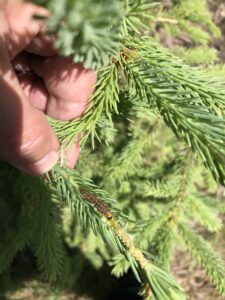
Another option for young stands where the trees are 15’ or less is to grind them up into wood shreddings with a Fecon mower. “It creates a nice layer on the ground and gets rid of your dead or dying trees. Fecon mowers are becoming easier to find for rental or to hire someone who has one who will come to your property,” says Williams.
“Some owners have left dead spruce as wildlife habitat, but if you get too many, you are increasing your fire risk,” she says. Dead trees can also be cut and piled. The piles do create some habitat for certain species, but Williams noted burn piles need to be kept to a manageable size and may require a special burn permit from the DNR.
“In many areas of the north woods, conifers are one of those key species that give the area its flavor,” Williams adds. “People really like conifers around their houses and cabins, and when they see their trees looking thin or starting to die back, they get concerned. The dead trees look ugly and can be a fire hazard.”
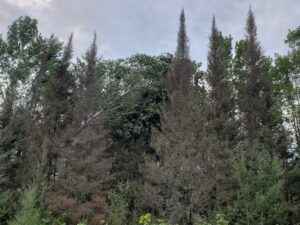
To protect specific trees, Williams suggests controlling the caterpillars by spraying a Bacillus thuringiensis (BT) product. “It is specific to caterpillars,” Williams explains. “You spray it on the needles, the caterpillars eat it, get sick, and die. You can also spray a regular insecticide.”
“Systemic pesticides are also an option for yard trees people want to protect,” she added, “but because they are such an early defoliator, you have to get right on it in the early spring. The first thing to look for is that, as the needles are emerging, whether some of them are webbed together. If you pry the webbing part, there will be a caterpillar in there.”
“Eventually, the spruce and fir trees will grow back. We have a long history of spruce budworm outbreaks,” says Williams. “You can look at soil cores in swamps and see tree rings of old trees that fell down and were covered up and preserved. This tells us when past outbreaks have occurred. And as happens, we’re having a spruce budworm outbreak going on now.”
